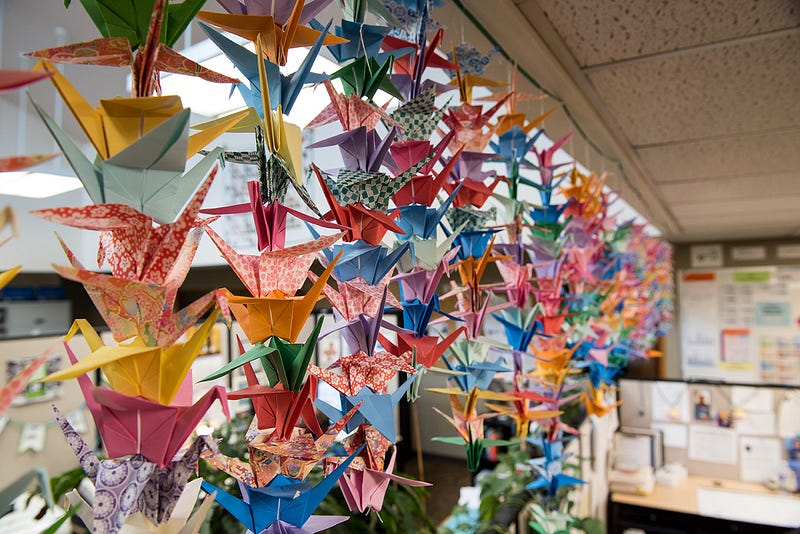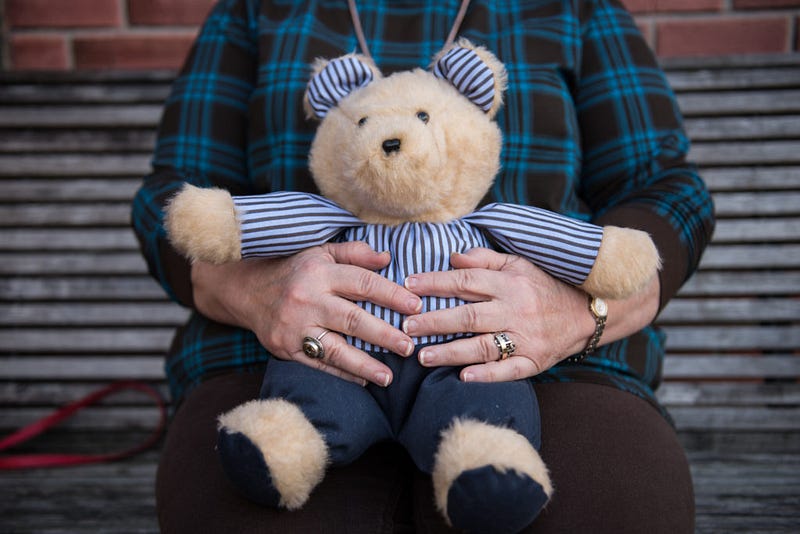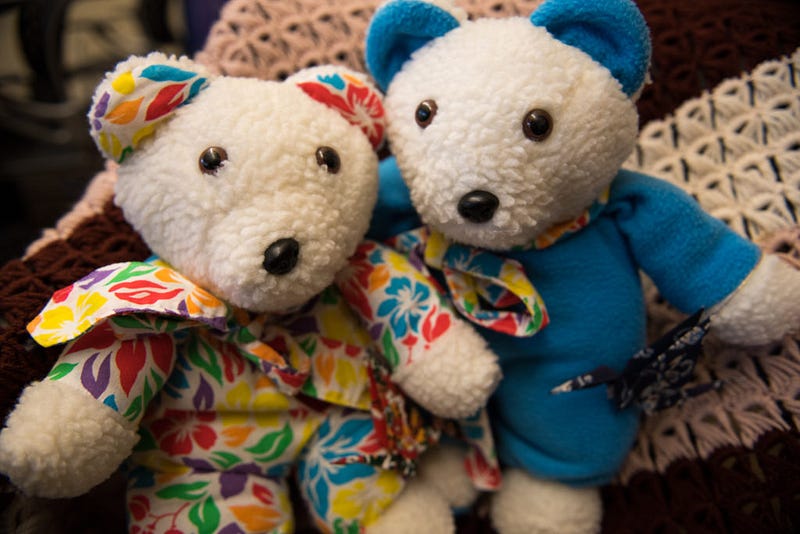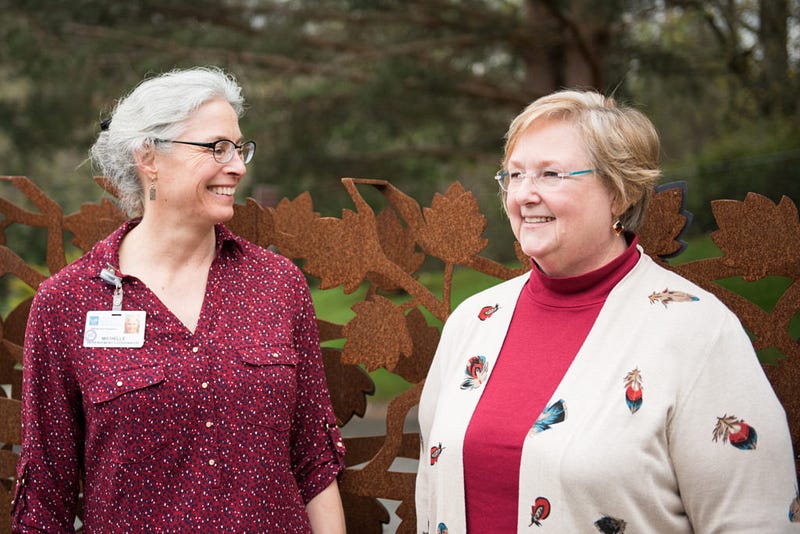The Art of Grieving

Whatcom Hospice connects people with memories of passed loved ones
Written by Janae Easlon // Photos by Daisey James
Pale sunshine hits the back wall of a Whatcom Hospice conference room, illuminating a quilt with autumn colors. Four houses made of fabric squares make up the middle of the quilt, each with its own personality and shades of green, red and orange.
The quilt itself has a story, one that fills Bereavement Coordinator Michelle Walsh’s face with a large smile, the skin around her bright gray eyes crinkling as she sits across from it at the grief support table.
Originally donated to a local food bank, the quilt made its way to the hospice. No one knew who the creators of the quilt when it was hung up on the wall. Then one day, Michelle witnessed what she calls a miracle.
“Three women, two sisters and a friend, came in here for the grief support group and noticed it. You could see them staring at it for a long period of time,” Michelle says. “They told me after spending over an hour here, they were the very people who made the quilt.”
The world of grief support is so small, so she thought the women seeing a quilt they donated many years ago was a way to bring the women full circle, she says.
After being in social work around the country for more than 25 years, Michelle felt this was one moment being a part of bereavement services made a difference.
Grief in Bellingham
PeaceHealth Whatcom Hospice is one of the few grief support groups in Bellingham, Washington.
The brochure Michelle hands to all new families who are offered grief services rests in her lap. The cover depicts a flower losing its petals, with the words “When You Are Grieving, a guide to understand loss.”
Inside, the first page reads: “Grief is not a disorder, a disease or a sign of weakness. It is an emotional, physical and spiritual necessity, the price you pay for love. The only cure for grief is to grieve.”
The effects of grief encompass two separate strands — the emotional and the physical.
Physical effects of grief and loss include shortness of breath, empty feelings in the stomach, sleep disturbances and sensitivity to noise and lack of energy, according to the National Association of Social Workers.
The grieving can experience the emotional waves of disbelief, confusion, trouble remembering and lack of concentration.
“Most people think of grief counseling as being sad, depressing and heavy,” Michelle says. “That is only a part of it.”
Michelle describes death as having a history of dark symbolism in the United States. “Back then, you would hang a veil on your door to signal a death. People would tip their hats if you walked down the street. It isn’t like that with the hustle and bustle of today,” she says. “It is like today you have a ‘get over it’ stage and you need to move forward.”
WAYS TO EXPRESS GRIEF CREATIVELY
Keep a journal
Work in a garden
Meditate or do yoga
Write poetry or a story
Sing and play an instrument
Bereavement services are covered by Medicare, Michelle says. It is required to have additional support services available to family members of people who have died within the hospice.
For a consistent resource, Michelle mails out newsletters titled, “Leaves of Change” to grieving families four times a year. In a newsletter article about memory workshops, the beginning sentence states, “Death ends a life. It does not end a relationship.” This is one of the misconceptions of death, Michelle says.
Members of the support group at Whatcom Hospice are a part of the program for 13 weeks, and attend additional sessions if needed. The length of the program allows participants to create trustful relationships with one another.
Some sessions are filled with silence, and that is okay. There is no rush to talk through feelings, Michelle says.
The support group’s mission is to instill calmness as soon as the person walks through the door.
Commemorating the Past
To evoke feelings of connectedness to the passed loved one, the grieving will find ways to link objects and their memories to the deceased. Reliving memories is one coping mechanism to alleviate stress and uncertainty.
Whatcom Hospice conducts a memory workshop several times a year for individuals to attend. The purpose is to teach attendees to use clothing scraps of loved ones and make them into something new.
“Sometimes having an object can just feel very comforting. That object can be a photograph, a pillow,” Michelle says. “We invite people who are experiencing loss to create a linking object like a teddy bear or pillowcases made from a loved one’s clothing.”
From the hospice lobby to Michelle’s office hangs a wave of brightly colored paper cranes from the ceiling window. “Every crane represents a person we have lost at the hospice,” Michelle says. Over 500 cranes hang above the office, and many wait to be hung.
Dianne Gillespie, the Whatcom Hospice Volunteer Coordinator, shares the office with Michelle. She holds up a photo of a brown bear in a pink outfit.
“This bear was made by a woman who lost her baby,” Dianne says. “She made it from her baby’s blanket.”
Dianne has worked at the office since 1995 and has attended the majority of the teddy bear workshops, which began in 2011. Today, she works with Michelle to use creativity as a tool for grief for members of the grief support group.
“The hardest part for people is the first cut,” Dianne says. “That is the first step in letting go — understanding this isn’t going to be his shirt anymore, it is going to be a teddy bear.”

Terri Temple, a Whatcom Hospice volunteer, holds onto her teddy bear named Dale Jr. after her late husband. Temple made the bear in a memory teddy bear workshop at Whatcom Hospice in 2016.
Attendees are not only learning to make a bear, they are sharing stories and being with each other, she says.
“We aren’t performing therapy in these groups,” Dianne says. “We are offering them an opportunity for people to share their grief with others.”
A University of Utrecht study reported that grief support comes in different models depending on the grief experienced.
Feelings of shock, and using acceptance as the way to combat the grief is the first model. In the second model, grief support uses speaking about feelings of pain to evaluate yearning for someone who is gone. The third model aims to channel overwhelming feelings of despair into something positive, like artistic activities.
Terri Temple, a hospice volunteer, attended a bear workshop a few months after losing her husband in 2015.
Terri sits with Dale Jr. closely beside her. A blond-haired teddy bear with a pinstripe shirt and dark pants, his hazel eyes resemble her late husband’s.
“I tried to pick a teddy bear closest to my Dale as possible,” she says. “We would have been together fifteen years this year.”
Dale’s aunt bought him a teddy bear when he was born and kept it on his shelf. Once Terri saw it, she decided to buy him teddy bears wherever she went to add to his collection. When he passed, Dale owned more than 10 bears on his shelf from places like Canada and Scotland, Terri says. “All over the world, you can always seem to find a teddy bear,” she says.

Whatcom Hospice holds memory teddy bear workshops a few times a year. These two bears serve as examples for the grieving when using meaningful fabric to craft their own bears.
As a hospice volunteer, Terri saw family members differ on how to grieve over a loved one. “I think you should go with what you feel. There is no right way to grieve,” Terri says. “People will or won’t understand, but you have to do what works for you. It is the loss of something familiar, but suddenly it isn’t there anymore.”
For Terri, her grief ebbs and flows, peeling back little by little. “[It’s been] almost a year now, I still miss him intensely and there is this pain in my body,” she says. “Other days, I feel at peace because I know we had good years together.”
After Dale’s funeral, Terri says she felt like she needed to be alone, but later felt ready to talk about Dale with her loved ones. The scent from Dale’s clothing and leaving a picture of him on his recliner became ways for Terri to begin healing, she says. After traveling to all seven continents, Terri says she will continue to travel and do what she loves, like painting and reading.
“For our anniversary this year, I booked a trip to Iceland,” Terri says, holding her bear.
Michelle sees people finding their voice as they attend grief support. “What people don’t realize is we get a gift from everyone we work with and it is a two-way street,” Michelle says. “The beauty is that we connect in that space and time, and then you have to be able to let it go.”
In the grief support room at Whatcom Hospice, many bears lay on the table, each carrying their own story, much like the quilt on the back wall.
Clad in stitches and mismatched textiles, the teddy bears and quilt have one thing in common: they were made with love and hope.

Bereavement Coordinator Michelle Walsh, left, and Whatcom Hospice volunteer Terri Temple, right, stand in front of a sculpture at Whatcom Hospice together. The sculpture is made of leaves paid for by families to engrave and memorialize patient’s names.
